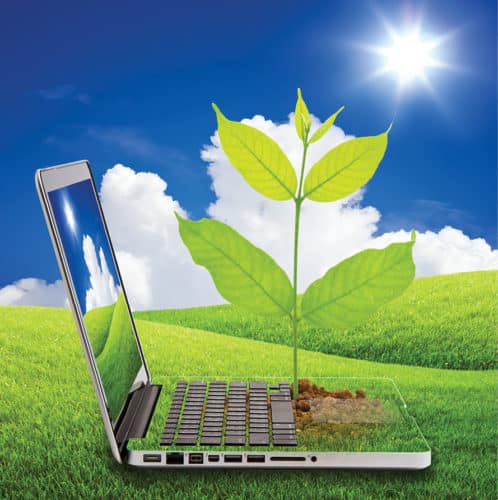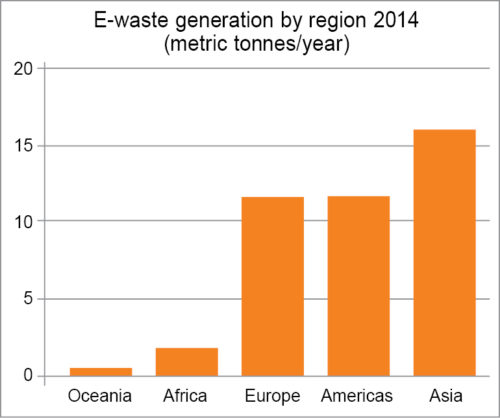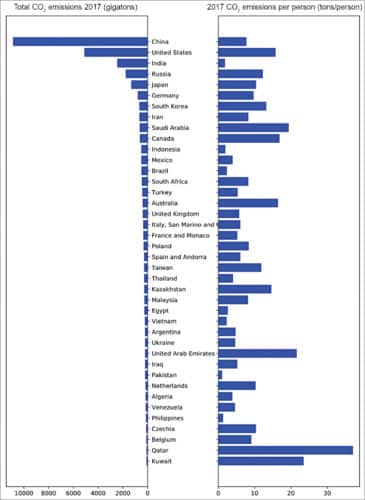Foundation of green computing was laid as far back as 1992 with the launching of Energy Star program in the USA. The success of Energy Star motivated other countries to take up the subject for investigation and implementation.
Any technology that aspires to be nature-friendly ought to be green. Recognition of this fact has led to development of green generators, green automobiles, green energy, green chemistry as well as green computing. Green computing is a leap forward for information technology (IT), and more specifically for information and communication technology (ICT). Green computing has emerged as the next wave of ICT.
Motivation for the subject of green computing arose to protect environment against hazards generated at three different states of ICT, namely, information collection (by electronic devices), information processing (through algorithms and storage) and information transportation (through networking and communication).
Carbon dioxide accounts for about eighty per cent of global warming. As a rule of thumb, if world-wide increasing application of ICT is assumed to contribute at least twenty per cent towards carbon dioxide, ICT becomes responsible for sixteen per cent of global warming. This is undoubtedly a cause of concern. As per one research-based estimate, fifty billion devices like computers, mobile phones, sensors, actuators and robots shall connect to the Internet by this year’s end, creating even more havoc.

Of course different strategies would be needed to nudge ICT towards green computing, which is necessary to reduce the pollutants generated in collection, processing and transportation of the information. In today’s scenario, primary challenge in achieving green computing is to realise energy-efficient devices, energy-efficient processing and energy-efficient networking. Invariably, energy efficiency is required to address reduction in heat dissipation that is basically responsible for emission of carbon dioxide.
In case of electrical, electronic or computer systems, wasteful heat is generated due to thermal vibration of particles in the components. Therefore any brute attempt towards green initiative should have direct or indirect motivation to reduce this thermal vibration.
Reduced circuitry or a minimal system helps in reducing the number of vibrating particles.
Minimal circuit designs, which lead to technologies of very large scale integration (VLSI) or ultra large scale integration (ULSI), are now well-established technical solutions. These solutions meet the objectives of realising low cost and smaller-size systems. It was never thought these would also indirectly provide a solution for reducing particles in vibration.
In the process of minimisation, two more revolutionary technologies have emerged: molecular scale of electronics (MSE) and Quantum computing. It was the quest for an ever decreasing size, but more complex electronic components with high speed ability, which gave rise to MSE.
The concept that molecules may be designed to operate as a self-contained device was put forwarded by Carter. He proposed some molecular analogous of conventional electronic switches, gates and connections. Accordingly, an idea of a molecular P-N junction emerged. MSE is a simple interpolation of IC scaling.
Scaling is an attractive technology. Scaling of FET and MOS transistors is more rigorous and well defined than that of bipolar transistors. But there are problems in scaling of silicon technology. In scaling, while propagation delay should be minimum and packing density should be high, these should not be at the expense of the power dissipated. With these scaling rules in minds, scaling technology of silicon is reaching a limit.
Dr Barker reported that, “change, spin, conformation, colour, reactivity and lock-and-key recognition are just a few examples of molecular properties, which might be useful for representing and transforming logical information. To be useful, molecular scale logic will have to function close to the information theoretical limit of one bit on one carrier.
Experimental practicalities suggest that it will be too easy to construct regular molecular arrays, preferably by chemical and physical self-organisation. This suggests that the natural logic architectures should be cellular automata: regular arrays of locally connected finite state machines where the state of each molecule might be represented by colour or by conformation. Schemes such as spectral hole burning already exist for storing and retrieving information in molecular arrays using light. The general problem of interfacing to a molecular system remains problematic. Molecular structures may be the first to take practical advantages of novel logic concepts such as emergent computation and ‘floating architecture’ in which computation is viewed as a self-organising process in a fluid-like medium.”
Change is the only thing that is permanent in universe. In technology scenario, changes become inevitable means of evolution and revolution. In tune, a new generation of IT known as Quantum Computing (QC) has come up. Mechanical computing, electronic computing, quantum computing, DNA computing, cloud computing, chemical computing and bio computing are a few generation-wise migrations of information technology (IT).
In conventional computers we work with now, computing and processing of data is based on transistors’ on and off states as binary representation of ‘1’ or ‘0,’ or vice versa. In quantum computers, the basic principle is to use quantum properties to represent data. Here, computation and processing of data is made with quantum mechanical phenomena such as superposition, parallelism and entanglement. Therefore, whereas in conventional computers data is represented by binary ‘bits,’ in quantum computers representation is done with ‘qubits’ (quantum bits).
Qubits are typically subatomic particles such as electrons and photons. Generating, processing and managing qubits is an engineering challenge. Superiority of quantum computing over classical computing is multi-fold. First, whereas in classical computing logical bits are represented by on and off states of transistors, in quantum computing qubits are harnessed by properties of subatomic particles. Size of quantum computers will thus be much smaller than that of present-day computers. Both MSE and QC are thus found to be indirect solutions for green computing.
At current state of technology march, Green ICT may be better looked at as a challenge to realise eco-friendly and environmentally-responsible solutions in order to reduce just not heat dissipation but also to maximise energy efficiency, recyclability and bio-degradability.
Fact is, fast-growing production of electrical, electronic and computing equipment has resulted in enormous increase of e-waste, and especially carbon dioxide, which is responsible for creating havoc in environment and for increasing pollution. As per a report published by International Telecommunication Union (ITU), e-waste has increased rapidly and reached a global high. Increasing trend of e-waste all over the world is shown in Fig. 1.

Many studies have established that computers and IT industries dissipate more energy than others. Impact of ICT industries on emission of carbon-dioxide is immense. As shown in Fig. 2, India is currently the third largest producer of carbon dioxide.

Urgent solutions required at the levels of hardware design management include minimal configuration, adoptive configuration, consolidation by virtualisation, algorithmic efficiency, optimal resource utilisation, optimal data centres, optimal link utilisation, limiting power by reducing cable length, minimising protocol overhead, protocol for compressed header, green networking, management of e-waste, air management and cooling management, among others. For ICT scientists and engineers, the challenge will be to design technology and algorithms to minimise particle vibration, travel path and heat loss due to input-output mismatch. Design, operational and transmission related thermal loss are core issues of ICT.
This makes production of Green ICT a great challenge, although, as parts of its implementation, energy- smart devices, sleep-mode devices, cluster computing, cloud computing, etc are already in place.
Foundation of green ICT was laid as far back as 1992 with the launching of Energy Star program in the USA. The success of Energy Star motivated other countries to take up the subject for investigation and implementation. Leading countries working on green ICT now include Japan, Australia, Canada and The European Union. Formalisation of green ICT is in fact due to standards proposed by IEEE who has formalised Green Ethernet and 802.3az-enabled devices for green ICT.
Green ICT is a clean-environment-based technology. However, fruitful realisation of green ICT is equally dependent upon awareness in society. Society needs to practice common ethics of ‘don’t keep computer on, when not needed,’ ‘don’t use Internet as a free tool, but as a valuable tool of necessity only,’ ‘don’t unnecessarily replace devices after devices just because you can afford to’ and so on. Without societal responsibility, technology alone cannot ensure achieving the objectives of green ICT.
Prof. Chandan Tilak Bhunia, PhD in computer engineering from Jadavpur University, is fellow of Computer Society of India, Institution of Electronics & Telecommunication Engineers, and Institution of Engineers (India)
Abhinandan Bhunia did B S in computer engineering from Drexel University, USA and MBA from University of Washington, USA






